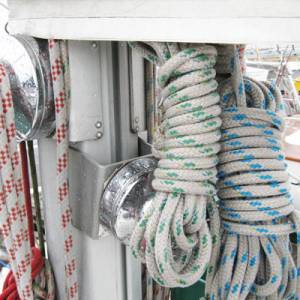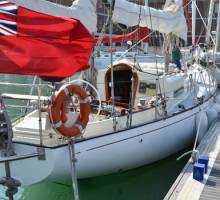
Getting your sail boat ready for sea
The process of getting your boat ready for sea is a therapeutic and systematic approach, I love the fact myself and my partner work away with no talking getting the boat ready. We tend to use the same mental check list for a small or long trip as its a real pain when you don’t lock the fridge or drawers fly open when you have a bit of a squall and you’re needed on deck, but need to clear the broken eggs up off the floor! Hence its great to be prepared always for long or short trips.
Its easy to be complacent in local waters inshore, but this is the time when most accidents will happen. Myself and my partner work through this check list and although we have various different jobs to do we end up finishing around the same time ready to get out on the water.
After a long winter on a marina, to “put the house away” and turn our boat into a sea going vessel it can take up to 2 hours and in cruising mode we can take a steady hour to get the boat ready. In an emergency and on anchorage and we have to leave in a hurry we can do this pretty much straightaway after getting the anchor up. (we’re always ready, no sail covers on, halyards on, key in ignition.)
The boat is a classic ketch 42 foot, GRP, owned her since 1996, several refits, lots of sailing and looking forward to this current season.
The night before we leave we always have a decent meal, most times no alcohol and drink plenty of fluids so you’re not dehydrated before you start your trip.
The below is our check list, but create your own, there's always something we will forget, usually the fridge!!
OUTSIDE BOAT
Single up all lines
Remove covers for main, mizzen
Unlock steering
Remove shore power lead
Get sheets ready
Stow anchor on deck
Unfurls main sheet reefing and bowline main and mizzen halyard on
Unfurl furler line for genoa
If rough hank on storm jib to inner stay, sheets
Instruments on
Check nav lights
Jack stays
Lock forehatch
Fill up with water
Put dinghy ondeck and outboard away
INSIDE BOAT
Check oil
Check fuel
Isolate cabin heater diesel
Check battery isolation master switch,
Switch on autopilot
Remove covers from instruments
Close seacokcs if rough weather
Lock fridge
Stow all books, shelves so nothing falls when healing on either tack!
Locks on chart table drawers so hey don’t fall open and spill all contents out
Place covers on saloon upholstery
Get quarter berth ready for hot bedding (pillows, sheets sleeping bags, hot water bottles)
Get dogs in lifejackets, bed ready, leads
PILOTAGE
Pilotage notes
Write up more sections of log book so don’t run out whilst at sea
Weather forecasts
Pilotage books
Charts have next charts in order in drawer
CREW
Just the two of us plus 2 dogs for northern hemisphere sailing, hence all the layers.
Clothes include, 2 layers of thermals, Mid layer, Oilies
Lifejacket safety line jack stays
Lucky hat with ears
Sunglasses
Good dose of sun cream on bits that show
Conditioner on long hair, plait and cover with hat
Its always too hot with all gear on when leaving so put lifejacket on without jacket
2 pairs of socks leather sailing Boots
FOOD
When we’re at sea we have a strict regime of cooking hot proper food as food is so important and looking forward to what’s prepared next is always exciting. We always prepare a tray of “grab food” ready in the galley for munchies. For the first night at sea, I might make a cottage pie, or have guinea fowl casserole cooked in the pressure cooker. I might buy some fab cornish pasties, place in oven plus makes the boat nice and warm for evening.
My favourite meals at sea:
Cruising Tortilla (I cheat and make this slightly differently whilst at sea.
6 Eggs, 6 med cooked potatoes diced, cheese, tomatoes, then place in oven to melt cheese and cook tomatoes ontop.
Lentil curry with eggs and aromatic rice
Pressure cook guinea fowl stew with pearl barley, (although always a bit nervous of eating fowl before going sailing, but this dish is delicious and then makes good thick soup. Cook, let go cold, then debone and re-heat properly when at sea.
Ready to fry toasted cheese sandwiches, butter bread on the outside, cheese in the middle and fry in frying pan. (The smell of cooked cheese is always welcoming on a boat.) These taste great on a nutty brown bread and lancashire cheese.
Fresh fish mackerel filleted and covered with sage and onion stuffing, place in brown bread and chomp away.
Tuna always best left to rest for 24 hours
GRAB TRAY
Crisps
Chocolate
Sliced brown bread
Cheese
Butter out
Ainsley Harriot cuppa soups
Noodles for emergency food if really rough.
MOVING OFF BERTH
Engine on 10 mins before we leave, check watering properly
Check or lines in water
Stow fenders and mooring warps soon after
Put main up as soon as possible
Coil up all sail ties and stow in cockpit locker
We hate towing dinghy places a lot of strain n dinghy, so always place on deck.
All these checks make a pleasant sailing experienced, you’re ready, prepared for anything and you can relax and enjoy the sailing.


